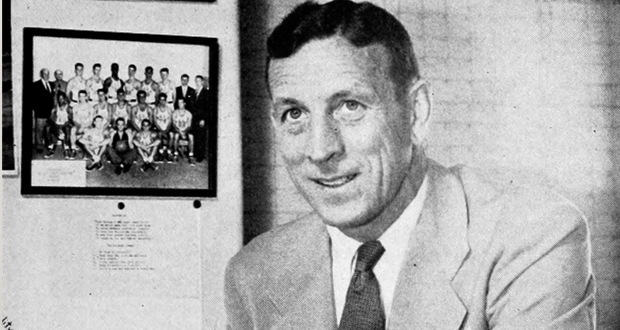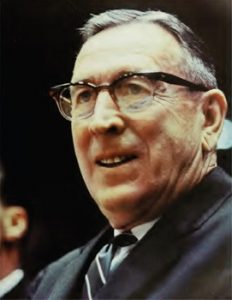Appropriately and logically, according to Coyle, Gallimore and Tharp began to question the education-based pedagogical resources, research and methodology they had been applying. In their attempt to try to discover what the problem was, they decided that “they would perform a detailed, up-close study of the greatest teacher they could find and use [these] results to help them” to improve the reading and literacy outcomes of their targeted students in Honolulu.
Basics to brilliance, part 2: resilience
Search for the greatest teacher begins
Their search for the ‘greatest’ teacher unexpectedly led them (not to a ‘classic’ education-based teacher), but to a basketball coach, that of John Wooden. Coach Wooden had been selected by ESPN (the Entertainment and Sports Programming Network) in America as being “the greatest coach of all time in any sport”. This decision by ESPN was based on Wooden’s college basketball coaching record. As coach, over a 12-year period, Wooden’s team had won 10 NCAA (National Collegiate Athletic Association) USA championships, and seven of these titles were consecutive victories.
A journey of questions and discovery commences
Within this time period, his team(s) had also won a record 88 consecutive games. During this time, Coach Wooden had also been named the national coach of the year six times. For Gallimore and Tharp, they decided that it was John Wooden they wanted to meet and speak with. And then, if this initial ‘meet and greet’ was successful, Gallimore and Tharp decided that if it was at all possible, they would then ask Coach Wooden if they could view and collect quantifiable observable data. The purpose of which was to find out if what they observed in the sports basketball coaching arena could be used to help them develop a successful reading and literacy-based program that would help them improve the reading, literacy and the connected learning potential of their cohort of students.
Meet, greet and agreement
Contact with Wooden was made. Much to their pleasure, Coach Wooden agreed to meet with Gallimore and Tharp. As alluded to above, this initial ‘meet-and-greet’ progressed to where Gallimore and Tharp asked Coach Wooden if they could observe and record what he was doing. Wooden was informed that the purpose of this process was to see, and even more importantly, understand how and why, he had achieved, and was still achieving, his outstanding overall coaching and correlated winning outcomes.
The quality of the coaching and the application of each athlete
In terms of presentation and coaching, Gallimore and Tharp found that Wooden was an unassuming, quietly spoken person. He did not present any lengthy talks, and neither did he present any loud, emotive-styled or ‘highly charged’ motivational speeches. Added to this Gallimore and Tharp observed that Wooden did not engage in any form of punishment regimes (for mistakes being made), and neither did he present what may be referred to as superficial platitudinal praise. What mattered to Wooden was the quality of the coaching, and the personal application and the associated passion and the pursuit of excellence of each athlete.
[I]t is important to understand the purpose of criticism. Criticism is not meant to punish, but rather to correct something that is preventing better results. The only goal of criticism or discipline is improvement. You must keep that in mind and try to the best of your ability to use tact." – John Wooden
The essence of the basics is what advances skills and outcomes
These combined principles, which, in essence, according to Wooden, is all about the basics, had the accompanying potential for achieving winning outcomes on the unforgiving sports arena. Wooden totally understood that sport was and is, in terms of results, all about and only about – winning! However, winning was and definitely is not possible without the necessary basic skills, the advanced skills and playing knowledge (all which is built upon the basics), and the associated universally linked personal application of discipline, dedication, determination, perseverance, unrelenting hard work, and resilience.
I wanted to win every single game I ever played in or coached. Absolutely. I wanted to win. But, I understood that ultimately the winning or losing may not be under my control. What was under my control was how I prepared myself and our team. I judged my success, my “winning,” on that. It just made more sense." – John Wooden
Application. Intense, short, sharp, structured, purposeful practise
In terms of application, what Gallimore and Tharp found in Coach Wooden was that he was a person who conducted very intense, highly structured and explicitly taught five to fifteen-minute skill drills. The training time overall was generally conducted from two to two-and-a-half hours. During this entire time there were no lengthy stoppages, lectures or ‘motivational you can do it, you’re the best,’ ‘we’re the best’ coaching talks. Whenever Wooden actually did stop a drill, which was not often, he rarely spoke longer than from 5 to 20 seconds. Whenever Wooden did talk, it was for an objective reason. The information he then presented was unequivocally focused on the specific action of a skill and/or the team drill that was being practised.
Feedback
During these brief stoppages, what Wooden was constantly doing was providing immediate feedback that was concise and unambiguously accurate. Interestingly, Coyle writes that Gallimore and Tharp were initially confused. In terms of reputation, with the ESPN title of being “the greatest coach of all time in any sport,” Gallimore and Tharp had expected to find a basketball ‘knight in shining armour’ who would not only be roaring and rallying ‘his troops,’ but would also be shouting out inspirational declarations, with related profound and purposeful ‘universal insights’ of wisdom and knowledge.
What took place however was far removed from this image. Instead, Gallimore and Tharp found in Coach Wooden that he was a humble, unassuming and quiet man, who resembled more of a modest, very busy, highly efficient and very successful office worker. Coyle reported that initially Gallimore and Tharp felt slightly deflated when they first observed ‘the quiet achiever’ Coach John Wooden.
Part 4 continues with the quest by Ron Gallimore and Roland Tharp to find the ‘greatest’ teacher of all-time. As noted, the fact is that so far Gallimore and Tharp are not convinced from their initial impressions that John Wooden was the end of their quest, and the start of their teaching and learning research. In fact, as noted, Gallimore and Tharp were, in effect, ‘slightly deflated.’ With that impression now being firmly in place and, as the judicious social adage informs (that first impressions are lasting impressions), the essential question that must now be asked is as follows: If two leading international academics, accomplished researchers, and highly skilled educational psychologists were not impressed with their initial meeting with John Wooden, should they stay on, or should they use their skills, and time more productively, and, as such, continue their quest to tracking down and finding the ‘greatest teacher of all-time?'

Dr Ragnar Purje is adjunct lecturer in the School of Education and the Arts at Central Queensland University. Under the supervision of Professor Ken Purnell, Purje’s doctoral dissertation focused on the success of his neurologically focused acquired brain injury rehabilitation therapy.
Do you have an idea for a story?
Email [email protected]
 Education Review The latest in education news
Education Review The latest in education news

